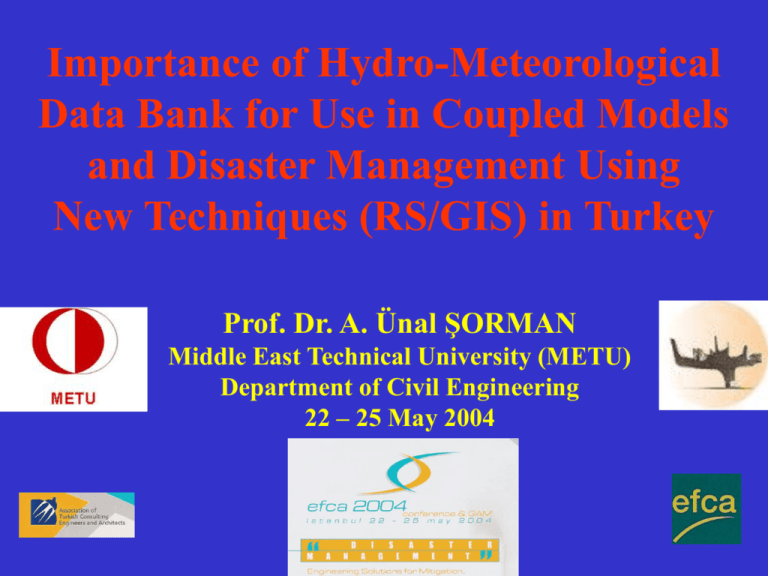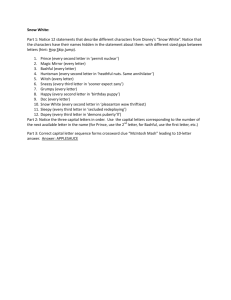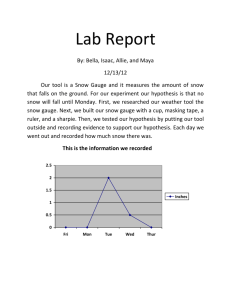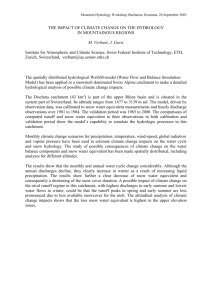Snow Studies in Turkey Past,Present & Future
advertisement

Importance of Hydro-Meteorological
Data Bank for Use in Coupled Models
and Disaster Management Using
New Techniques (RS/GIS) in Turkey
Prof. Dr. A. Ünal ŞORMAN
Middle East Technical University (METU)
Department of Civil Engineering
22 – 25 May 2004
Introduction
Speech can be divided into 5 main topics:
A. Importance of snow and data collection
B. Hydrological models and coupling with atmospheric
circulation models
C. Flood forecasting from early snowmelt/rainfall in 2004
(a case study in Turkey)
D. Scaling and meteorological data assimilation
E. Future research activities for operational runoff forecast
A. Importance of Snow and Data Collection
Snow is an important resource of water
Determination of SWE is important to forecast
the volume of spring melt
Ground truth is the main
data source in investigating
the snow covered areas
Reflectance values from
the snow surface should be
watched during the snow
melt period
Snow studies between 1964-2002
1. Snow observations
Classical methods (snow sticks, snow tubes)
# of stations
Electrical Res.
and Survey
Adm. (EİE)
1964
4
1969
6
30
1975
21
92
1997
2002
State
Hydraulic
Works (DSİ)
107
67
164
State
Meteorologic
Org. (DMİ)
•Measurements
are usually
collected
in/around
urban areas.
•Snow data
recorded as
SWE in mm.
Recent Studies by DSİ and DMİ
In TEFER project, 206 automated
meteorological stations are under
construction
3 radar stations are to be operated in
western regions of Turkey
Snow studies between 1964-2002
2. Snow research and modeling in basin scale
Basin wide snow studies were initiated by
METU, Tübitak-Bilten, EİE, DSİ and DMİ
under a protocol sponsored by NATO in 1997.
Snow in Eastern Turkey
Snowmelt
runoff
constitutes
approximately 60-70% of yearly
total volume in Euphrates (Fırat)
River, where major dams are located
in series (Keban, Karakaya, Atatürk,
Birecik and Karkamış).
Therefore forecasting the snow
potential in advance could result in
better management of the country’s
water resources.
Automated Snow & Meteorological
(Snow-Met) Stations
Because of high snow potential, Karasu Basin
in the Upper Euphrates is selected as a pilot
basin for snow studies
Karasu Basin
Station Locations in Karasu Basin
Station
(Elevation)
Data Logger
Wind Speed
Çat
(2340 m)
X
X
X
X
Hacımahmut
Sakaltutan
(2150 m)
X
Güzelyayla
(2065 m)
X
X
X
X
X
X
X
X
X
X
X
X
X
X
Global Radiation
X
X
X
X
X
X
X
X
X
X
X
X
X
X
X
X
X
Real Time Data
Transfer
X
Snow Pillow
Lysimeter
Soil Temp.
Rain Gauge
Albedo
Net Radiation
Thermal
Radiation
Air Pres.
X
Snow Depth
(1965 m)
Relative Hum.
(2170 m)
Air Temp.
Ovacık
Wind Direction
Station Instrumentation
X
X
X
X
X
X
X
X
X
X
X
X
X
X
X
Güzelyayla Snow-Met Station
Elev: 2065 m
Lat: 40o12`19``
Long: 41o28`18``
Sensors
Rain Gauge
Snow pillow
Snow Lysimeter
Güzelyayla Snow-Met Station
Sensors
Temperature and Relative Humidity
Sensor
Ultra Sonic Depth
Sensor
Inmarsat
Antenna
Wind Speed and Direction Sensor
Net Radiometer
Solar Radiation Sensor
Güzelyayla Snow-Met Station
Snow Pillow
3 meter Diameter Hyphalon Snow Pillow
Güzelyayla Snow-Met Station
Snow Lysimeter
Snow Lysimeter
measures the
• amount
• rate
• duration
of snow melt
Snow-Met Station
Communication
Satellite
Snow-met Station
Data from snow-met
stations are downloaded
via satellite or GSM
where available.
METU Office
Snow-Met Station
Processed Data
200.000
70
180.000
60
Snow Depth
140.000
Lysimeter
50
120.000
40
100.000
80.000
60.000
Snow Water
Equivalent
30
20
40.000
10
20.000
0.000
1-Mar-03
8-Mar-03
15-Mar-03
22-Mar-03
Kar Su Eşdeğeri (mm)
29-Mar-03
5-Apr-03
Date
Lizametre Toplam (mm)
12-Apr-03
19-Apr-03
26-Apr-03
Kar Derinliği (cm)
Snow data, 2003 water year
0
3-May-03
Derinlik (cm)
KSE(mm), Lizamatre (mm)
160.000
Snow Studies Concentrate on
Snow cover area monitoring – SCA
Snow water equivalent analysis – SWE
Snow albedo measurements - Albedo
Snow Cover Area (SCA)
National Oceanic and Atmospheric Administration (NOAA)
Temporal Resolution: 2 or 3 times a day
Spatial Resolution: 1.1 km
• Supervised
Classification
• Unsupervised
Classification
• Threshold (Theta
Algorithm)
Snow Cover Area (SCA)
13 April 1998 Geocoded NOAA Image
Snow Cover Area (SCA)
Special Sensor Microwave/Imager (SSM/I)
Temporal Resolution: 1 or 2 times a day
Spatial Resolution: 30 km
Modified Grody/Basist Algorithm, 3 April 1997
Snow Cover Area (SCA)
Moderate Resolution Imaging Spectroradiometer (MODIS)
Temporal Resolution: 1 or 2 times a day
Spatial Resolution: 0.5 km
5 April 2004
Snow Cover Area (SCA)
13 April 1997
Supervised Class.
13 April 1997
Snow Covered Area
Snow Water Equivalent (SWE)
Snow Water Equivalent is the actual amount
of water stored in the basin which will turn into
runoff once snow melt occurs.
Snow Water Equivalent (SWE)
Snow pillows are used to measure continuous SWE at a point
SWE data are randomly checked by snow tube measurements
done by state organizations near snow-met stations
Hacimahmud
Hm_DSI
Guzelyayla
Gy_DSI
Ovacik
Ova_DSI
Cat
Cat_DSI
400
375
350
325
300
275
SWE (mm)
250
Station SWE,
2003 Water Year
225
200
175
150
125
100
75
50
25
0
01-11-02
15-11-02
29-11-02
13-12-02
27-12-02 10-01-03 24-01-03 07-02-03 21-02-03 07-03-03 21-03-03 04-04-03 18-04-03 02-05-03
Snow Albedo
Albedo is a very critical parameter in snow as it determines
the amount of absorbed solar energy (major energy for
snowmelt) for melting process to take place, “Energy Budget”.
Dry fresh snow albedo ~ 0.80-0.90
Wet dirty snow albedo ~ 0.20-0.30
Snow albedo is a function of snow
grain size, depth, age, impurities…
Albedometer present at Güzelyayla and Ovacık Snow-met stations
Snow Albedo
Daily Average Albedo, Winter of 2003-2004
Guzelyayla
Ovacik
1.000
0.900
0.800
0.700
0.600
0.500
0.400
0.300
0.200
0.100
0.000
01-Nov-03
15-Nov-03
29-Nov-03
13-Dec-03
27-Dec-03
10-Jan-04
24-Jan-04
07-Feb-04
21-Feb-04
06-Mar-04
Daily average snow albedo, 2004 water year
20-Mar-04
Snow Albedo
MODIS Albedo
Daily and 16-day albedo values
from MODIS Aqua/Terra satellite
are analyzed
Snow albedo variation is significant especially
during snow ablation stage. Therefore, temporal
variation as well as spatial variation is important
Snow albedo is used in energy balance models and
modified temperature index models in hydrologic
modeling
B1. Hydrological Models
SRM (Snowmelt Runoff Model)
Switzerland-USA, Temperature Index Model
HBV (Hydrologiska By-rans avdeling for Vattenbalans)
Sweden-Norway, Temperature Index Model
SNOBAL (Snow Balance)
USA, Point Two Layer Energy Balance
Hydrologic Models (SRM)
Qn+1 = [cSn . an (Tn + Tn) Sn + cRn . Pn] (A.10000/86400) (1-kn+1) + Qn kn+1
Snow melt
Flow
Recession
Rainfall
Parameters
Variables
• Snow Covered Area (S)
• Temperature
• Precipitation
(T)
(P)
• Snow runoff coef.
(cSn)
• Rain runoff coef.
(cRn)
• Degree day factor
(a)
• Temp. lapse rate
(γ)
• Critic temperature
(Tcrit)
• Rainy area
• Recession coefficient
• Time lag
(RCA)
(k)
Hydrologic Models (HBV)
Model Structure
Snow routine
Critical Temp, Degree day,
Rain/Snow correction coeff.
Soil Moisture
Field Capacity, Pot. Evap.
Upper Zone
Quick recession coeff.
Lower Zone
Slow recession coeff.,
Percolation
Hydrologic Models (SNOBAL)
Q = Rnet + H + LE + G + M
Q:
Rnet:
H:
LE:
G:
M:
net energy change in snowpack (W/m2)
net radiation (W/m2)
sensible heat flux (W/m2)
latent heat flux (W/m2)
ground heat (W/m2)
advection (W/m2)
Near Real Time Forecasts
NOAA
(optic)
SSM/I
(passive mw)
MODIS
(optic)
METU
Web site
cd/ftp
Modem-Satellite
Phone
Hydrologic models
DSI
Runoff Stations
GSM
ftp
ECMWF
MM5
DMI
ECMWF
GRIB format
Grided Binary
Boundary
Conditions
(40x40km)
Remote Sensing
NOAA/AVHRR
MODIS
GIS
High spatial elevation model
MM5
(9x9km) [1.2GB]
Format
Conversion
NCAR
Non hydro static
Atm. Model
Forecasted
Grid Data
Model Variables
(Temp., Prec.)
Model Parameters
Snow Covered
Area
Basin
Characteristics
Grid Distributed
SCA
P/ T
Hydrological
Models
Forecasted
Runoff
Integration of Real Time Atmospheric and Hydrological Models for
Runoff Forecasts in Turkey
Results & Conclusions
from hydrological model studies
Formation of a common digital data banks
Format conventions and parameter selections
Enabling research oriented data sharing
Installation of new hydro meteorological
stations and quality increment by optimization
Use of RS and GIS in basin model studies.
Related software, hardware and satellite
selection.
Results & Conclusions
from hydrological model studies
Simulation and forecast studies by
Lumped/Distributed (full/semi) models in
{daily, monthly and yearly basis}
Providing the cooperation between
universities and governmental organizations
Selection of projects having national priorities
B2. Atmospheric – Hydrological Model
Coupling
Atmosphere – Circulation
Atmosfer – Sirkülasyon
Models
Modelleri
(Forecast or Analysis)
GCM ve RCM
ve RCM
• GCM
Global ECMWF
– ETA
• Global,
ECMWF
– ETA
(40 km
– 40 km)
(40 km
– 40 km)
(6 saat)
(6 hr)MM5
•Bölgesel
• (9
Regional,
MM5
km – 9 km)
(9 km
– 9 km)
(1 saat)
(1 hr)
Hydrological Models
Energy and Mass Balance
Operational Models
Models
(Lumped and distributed)
(Lumped and distributed)
Elements of Hydrologic Cycle
State and Diagnostic Parameters
(Snow water equivalent, depth, snow surface temperature,
Elements of net energy, melt speed,
Stream flow, etc.)
Model Input Flow
Grid
•Atmospheric Weather Prediction
Geophysical Maps
(Digital elevation Model,
Land use,
soil type, vegetal cover)
(Analysis or Forecast)
• NOAA / AVHRR Images
(1100 m resolution)
(Snow covered area, cloud, land)
Physical
Downscaling
Point
•MODIS Images
•Meteorologic observations
•Hydrometric flow observations
(500 m Resolution)
(Snow covered area, albedo)
Quality Check
Hydrological Model
Model Integration and Outputs
Atmospheric Model
(Forecast/Analysis)
Forecast / Analysis data
Air temperature
Precipitation (rain/snow)
Wind
Humidity
Air Pressure
Cloud
Integration
Hydrological Model
(Operational /
Research)
State and Diagnostic Data
Snow water equivalent
Snow depth
Snow covered area
Snow temperature
Melt rate
Flow
Energy flux
Physical Downscaling of Thermodynamic
Variables
Thermodynamic Variables
(Pressure, Temperature, Humudity)
DEM
Elevation greater than
Model elevation?
Yes
No
Extrapolate temperature and virtual
Temperature to DEM elevation;
Compute pressure via hydrostatic
relation
Interpolate pressure, temperature
and virtual temperature
to DEM elevation
Derive relative
humudity from
temperature and
pressure
ECMWF DEM Turkey
MM5 DEM Turkey
Terrain
MM5 Land Use Map
ECMWF Temperature (3 May 2004)
MM5 Temperature (3 May 2004)
Read Interpolate Plot (RIP)
Air Temperature (3 May 2004)
Read Interpolate Plot (RIP)
Precipitation (3 May 2004)
C. Analysis of the early 2004
flood event
An unexpected snowmelt event
has occurred during late
February and early March of
2004
in the eastern and
southern parts of Turkey
An analysis of the flood event is
simulated using +1 day weather
forecast data in a hydrological
model to forecast runoff in
Upper Karasu Basin (Kırkgöze
Basin), where real time ground
data (snow, meteorological,
stream flow) are collected
Hydrological Runoff Forecasting
HBV Model (Temperature Index Model)
Input data into HBV model from global weather
forecasts (ECMWF)
Daily total precipitation
Daily average air temperature
Forecast simulations during the period of
28 February - 7 March 2004 in Kırkgöze Basin
Global Weather Forecasts - ECMWF
Daily Total Precipitation (mm)
of 5 May 2004
Air Temperature (oC)
of 5 May 2004 12:00
Hydrological Model (HBV)
Runoff Forecast
Observed and Calculated Runoff for : Kırkgöze (R2=0.64)
Observed
3
m /s
Calculated
18
16
14
12
10
8
6
4
2
0
1-Feb-04
8-Feb-04
15-Feb-04
22-Feb-04
29-Feb-04
Observed and calculated runoff hydrographs
at Kırkgöze Basin outlet, DSİ 21-01
7-Mar-04
Hydrological Model
Forecast Results
R2, Nash efficiency criterion, is used in HBV model to
show the goodness of fit of the observed and calculated
values (from - to +1.0, the higher the value the better the
model fit).
2
2
Q
Q
Q
Q
O O S O
R2
2
QO Q O
where
QO
=observed runoff,
QO
=average runoff,
QS
=calculated runoff
Normal values during HBV model calibrations are
within the range 0.5-0.9. For this analysis, R2 is 0.64.
D. Data Assimilation and
Downscaling
1. Data collection, analysis and storage
2. Quality control
3. Physical downscaling of numerical weather
prediction (ECMWF and/or MM5) model outputs
4. Real time forecasting of stream flow with
hydrological models
5. Comparison of model outputs with observations
6. Data assimilation and renew
Tools
Satellites
Aircrafts
Balloons
Meteorological
Weather
Stations
Products
Snow covered area
Users
Snow depth
DSI, DMI
Snow water equivalent
EIE, KHGM
Snow surface temperature
Ministry of
Env. and Forest
Precipitation
Soil moisture
Downscaling
40 km
1 km
Temperature and Precipitation Biases
E. Future research activities for
operational runoff forecast
Develop/validate hydrological models and
coupled model sub-components. Improve
precipitation (snow/rain) and runoff processes
related to spring snow accumulation/melt
Conduct experiments to understand the effects of
terrain data (DEM, land use, soil moisture,
vegetation)
Evaluate the effects of coupled model resolution
on seasonal and diurnal land-surface atmosphere
interactions in complex terrain regions.
Develop techniques for assimilating new Remote
Sensing products for MODIS / LANDSAT
Develop and understand cold season precipitation
including snow and frozen-ground
Investigate the effects of climate change senarios
for mid and long term
Assess and improve runoff models in coupled
form to validate streamflow estimates to be used
by managers / decision makers
Decrease the effects of flood and drought with
water resources planning strategies
THANK YOU








